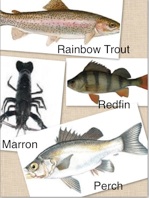Drakesbrook Weir
Please note the following in relation to the Drakebrook Weir Dam:
MARINE SAFETY
SUMMARY OF GAZETTAL NOTICES AND AREAS
February 27, 2017
METRO – PEEL
DRAKESBROOK DAM
CLOSED WATERS – MOTORISED VESSELS
All waters of the Drakesbrook Dam are hereby closed to motor boats (excluding electric powered).
Published : 30/9/05
Construction of the Weir
In 1931 the construction of the Waroona Weir commenced and it was completed in 1932. The Weir was constructed mostly by hand, with a small amount of machinery. Shovels, picks, wheelbarrows and a small bulldozer were used in its construction. The workers camped in tents, or if they were lucky, they owned one of the three houses close by. Most of the workers were locals. Work was hard and living conditions were just as hard.

Creatures and measurements
The Weir holds 2,290 ML but it only has 1870 ML of water in it at present. The catchment area of the Weir is 5900 hectares and has a surface area of 417 hectares.
The Drakesbrook Weir is an irrigation weir, which collects the water overflow from the Waroona Dam. Farmers used the water for their livestock and crops. The Weir is a home to Rainbow Trout, Redfin, Perch and Marron. Some of those creatures are hard to find.
Upgraded facilities and things to do
The Weir has just had a makeover and now has upgraded toilets facilities, swimming area, shady parking, beach sand, solar lighting, barbecues and shelters. The Weir is a great place to have a barbecue, picnic or just a relaxing swim. There is a pontoon to keep the children entertained. The children use the pontoon for jumping off or having wrestling matches with the loser falling into the water. These are some of the activities the Weir is used for: Swimming, canoeing, swimming classes, school swimming carnivals, bushwalking and fishing. Sometimes events like Australia Day celebrations, family picnics and raft building competitions were held there. Powerboats and dogs are prohibited at the Weir.
_scaled.JPG)
Noisy Scrub Bird
 The first discovery of the Noisy Scrub bird was made in Waroona by John Gilbert and James Drummond in 1842. It was discovered in Drakes Brook Valley. The birds were rarely seen; so many people thought they were extinct. 1n 1961, the Noisy Scrub bird was rediscovered in Albany. The Noisy Scrub Bird is a small solidly built bird, with a strong pointed bill, powerful legs, graduated tail and short round wings. They are brown above white with a dark cross barring extending from its head to the tip of its tail. The bird is semi-flightless and only weighs 35-55g. It eats ants, beetles and spiders. It lives in the trees near the water, scavenging for bugs and other food. The Noisy Scrub Bird was rereleased by Alcoa in the late 1990’s to increase numbers in the wild.
The first discovery of the Noisy Scrub bird was made in Waroona by John Gilbert and James Drummond in 1842. It was discovered in Drakes Brook Valley. The birds were rarely seen; so many people thought they were extinct. 1n 1961, the Noisy Scrub bird was rediscovered in Albany. The Noisy Scrub Bird is a small solidly built bird, with a strong pointed bill, powerful legs, graduated tail and short round wings. They are brown above white with a dark cross barring extending from its head to the tip of its tail. The bird is semi-flightless and only weighs 35-55g. It eats ants, beetles and spiders. It lives in the trees near the water, scavenging for bugs and other food. The Noisy Scrub Bird was rereleased by Alcoa in the late 1990’s to increase numbers in the wild.